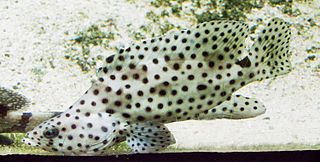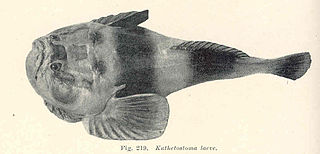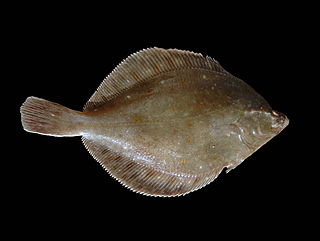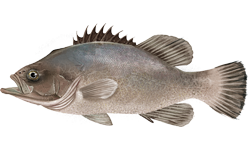
The Percidae are a family of ray-finned fish, part of the order Perciformes, which are found in fresh and brackish waters of the Northern Hemisphere. The majority are Nearctic, but there are also Palearctic species. The family contains more than 200 species in 11 genera. The perches and their relatives are in this family; well-known species include the walleye, sauger, ruffe, and three species of perch. However, small fish known as darters are also a part of this family.

Serranidae is a large family of fishes belonging to the order Perciformes. The family contains about 450 species in 65 genera, including the sea basses and the groupers. Although many species are small, in some cases less than 10 cm (3.9 in), the giant grouper is one of the largest bony fishes in the world, growing to 2.7 m in length and 400 kg (880 lb) in weight. Representatives of this group live in tropical and subtropical seas worldwide.

Halosaurs are eel-shaped fishes found only at great ocean depths. As the family Halosauridae, halosaurs are one of two families within the order Notacanthiformes; the other being the deep-sea spiny eels, Notacanthidae. Halosaurs are thought to have a worldwide distribution, with some 17 species in three genera represented. Only a handful of specimens have been observed alive, all in chance encounters with Remotely operated underwater vehicles.

The stargazers are a family, Uranoscopidae, of labriform ray-finned fish that have eyes on top of their heads. The family includes about 51 species in eight genera, all marine and found worldwide in shallow and deep saltwaters.

The Gonostomatidae are a family of mesopelagic marine fish, commonly named bristlemouths, lightfishes, or anglemouths. It is a relatively small family, containing only eight known genera and 32 species. However, bristlemouths make up for their lack of diversity with relative abundance, numbering in the hundreds of trillions to quadrillions. The genus Cyclothone is thought to be one of the most abundant vertebrate genera in the world.

Abalistes is a small genus of marine ray-finned fishes belonging to the family Balistidae, the triggerfishes. These triggerfishes are found in the Indo-Pacific and eastern Atlantic. This genus contains two recognised species.

Members of the genus Lophius, also sometimes called monkfish, fishing-frogs, frog-fish, and sea-devils, are various species of lophiid anglerfishes found in the Atlantic and Indian Oceans. Lophius is known as the "monk" or "monkfish" to the North Sea and North Atlantic fishermen, a name which also belongs to Squatina squatina, the angelshark, a type of shark. The North European species is Lophius piscatorius, and the Mediterranean species is Lophius budegassa.

Pleuronectidae, also known as righteye flounders, are a family of flounders. They are called "righteye flounders" because most species lie on the sea bottom on their left sides, with both eyes on their right sides. The Paralichthyidae are the opposite, with their eyes on the left side. A small number of species in Pleuronectidae can also have their eyes on the left side, notably the members of the genus Platichthys.

Anthias are members of the family Anthiadidae in the order Perciformes. The group has also been called Anthiidae or Anthiinae, but these names are preoccupied by a subfamily of ground beetles in the family Carabidae erected by Bonelli in 1813.

Echinorhinus is the only extant genus in the family Echinorhinidae.

Notothenioidei is one of 19 suborders of the order Perciformes. The group is found mainly in Antarctic and Subantarctic waters, with some species ranging north to southern Australia and southern South America. Notothenioids constitute approximately 90% of the fish biomass in the continental shelf waters surrounding Antarctica.

Longneck eels or neck eels are a family, Derichthyidae, of eels. They are pelagic fishes, found in the middle and depths of most oceans. The name comes from Greek deres meaning "neck" and ichthys meaning "fish".

The wreckfish are a small group of ray-finned fish in the genus Polyprion, belonging to the monotypic family Polyprionidae in the order Acropomatiformes.

Aplodactylus is a genus of marine ray-finned fishes, commonly known as marblefishes or sea carps. It is the only genus in the monogeneric family, Aplodactylidae. The fishes in this genus are found in the south eastern Indian Ocean and the southern Pacific Ocean.

Parapterois is a genus of marine ray-finned fishes belonging to the family Scorpaenidae, the scorpionfishes. These fish originate from marine environments in the Indian Ocean or near it. The venomous Parapterois heterura is occasionally seen as an aquarium fish.

The trumpetfishes are three species of highly specialized, tubularly-elongated marine fishes in the genus Aulostomus, of the monogeneric family Aulostomidae. The trumpetfishes are members of the order Syngnathiformes, together with the seahorses and the similarly built, closely related cornetfishes.

The Platycephalidae are a family of marine ray-finned fish, most commonly referred to as flatheads. They are relatives of the lionfish, and belong to the order Perciformes.

Gymnocephalus is a genus of ray-finned fishes from the family Percidae, which includes the perches, pike-perches and darters. They are from the Western Palearctic area, although one species, Gymnocephalus cernua has been accidentally introduced to the Great Lakes region where it is regarded as an invasive species. They have the common name "ruffe" and resemble the true perches in the genus Perca, but are usually smaller and have a different pattern.

The sailfin tang, the Pacific sailfin tang, purple sailfinned tang or sailfin surgeonfish, is a marine ray-finned fish belonging to the family Acanthuridae which includes the surgeonfishes, unicornfishes and tangs. This fish is found in the Pacific Ocean and is popular in the aquarium hobby.

Ctenochaetus strigosus, the kole tang, spotted bristletooth, spotted surgeonfish, goldring bristletooth, goldring surgeonfish, yelloweye tang or yellow-eyed surgeonfish, is a species of marine ray-finned fish belonging to family Acanthuridae which includes the surgeonfishes, unicornfishes and tangs. This fish is endemic to Hawaii.




















